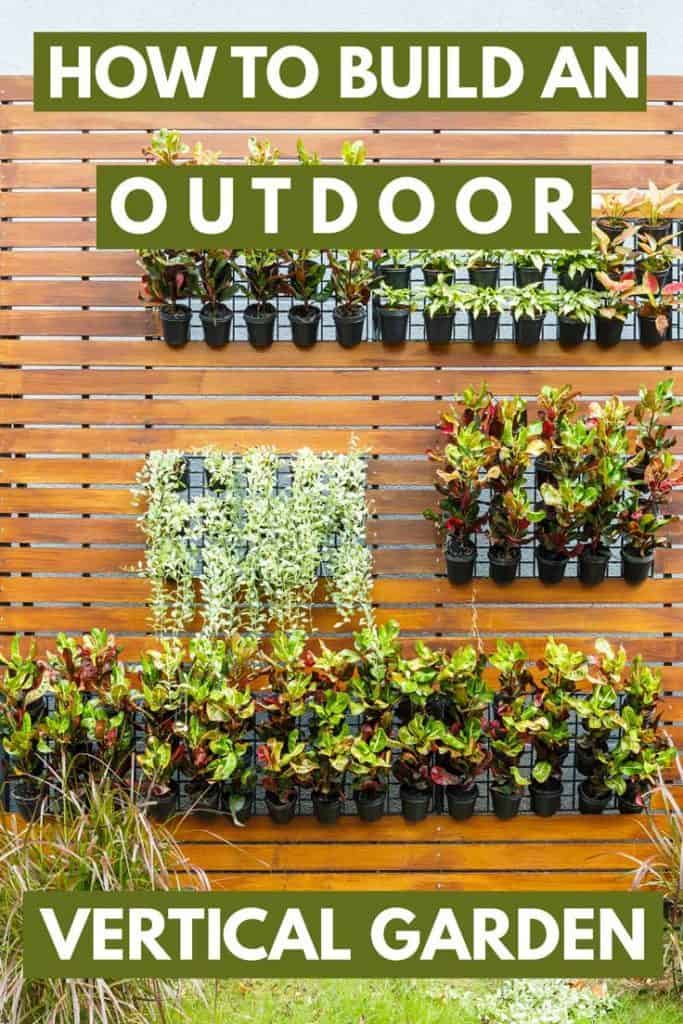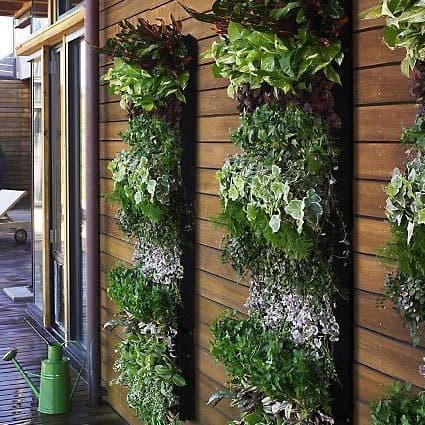If you have limited outdoor space, you might decide to install a vertical garden to maximum effect. But how do you build an outdoor vertical garden? I have researched this and am happy to share this information with you.
 To build an outdoor vertical garden requires proper planning and preparation. Below are 9 steps to get you on your way to a beautiful garden space.
To build an outdoor vertical garden requires proper planning and preparation. Below are 9 steps to get you on your way to a beautiful garden space.
- Choose your location.
- Decide what type of vertical garden structure you want to use.
- Install the structure, making sure that it is sturdy and secure.
- Choose the plants for your garden.
- Plant according to your plants’ soil and spacing needs.
- Devise a watering system or schedule.
- Fertilize according to your plants’ requirements.
- Maintain Your Garden
There are a lot of variables to each of these steps which I have outlined below to help you make the best decisions for your garden. And it will be worth it! After all, gardening can be a very rewarding and relaxing experience. It has been proven to reduce stress, plus you get to enjoy fabulous garden space and even produce as a result of your efforts.
Other plants would go perfectly with vertical gardens, here's how to grow geraniums!
1. Choose your location

The location of your vertical garden can change everything, from the types of plants that you choose to what kind of watering system you need.
Are you putting your garden in the sun, the shade or a combination of both? This is very important because most flowering plants, fruit, and vegetables need full sun to be successful.
Do you want to use your vertical garden to hide an ugly fence or wall?
Are you growing a vegetable garden in a limited space like a patio or balcony?
2. Type of Structure
The type of structure that you choose depends on its location as well as what kind of plants you want to grow. For example, if you want to grow herbs, you won’t be able to use a trellis or teepee.
Trellis or Teepee Type Structure
A teepee is great for adding vertical growing space to a garden bed, especially for produce. They are great to train string beans or mini cucumbers up. On a patio or balcony where space is really limited, you can put one in a large planter which will increase your space for plants.
Click here to buy this teepee on Amazon.
When you want to cover a large surface or hide a fence or wall, trellises are perfect. Use them to support larger vining plants that cover a lot of surface area, such as climbing roses or clematis.
Click here to buy this trellis for your garden on Amazon.
Planters Mounted on Wall or Shelving Structure
This is what most people think of when they think of a vertical garden. There are lots of options for this kind of set up from do-it-yourself projects to commercially available options.
One great method is to mount containers with drainage holes drilled in them to a fence or wall. You can use metal, wood, or plastic containers. You just need to make sure that they have adequate support to hold the wet soil and full-grown plants.

Another option is to install a structure that can hold planters or containers. This method is perfect if you are going to choose plants that can be brought inside during the winter, such as herbs or other perennials.
If you are not the handy type, there are also several really incredible commercial options as well. Here are a couple of examples of what is available.
The Vertical Garden Wall Planter has deep pockets for your plants and mounts on any wall.
Retaining Wall with Plant Pockets
You can turn a retaining wall into a vertical garden so long as it has pockets in between the stones large enough for you to plug plants into them with a little bit of soil. If you choose this method, the type of plants that you choose is especially important. Desert plants such as cacti, or air plants are good choices as they do not have the same needs as other plants.
Read more: How to create a vertical garden in a retaining wall
Pallet Garden
If you are crafty, you can make a vertical garden out of a recycled shipping pallet. Just staple landscaping fabric to the back, then fill the entire pallet with potting soil. Secure the pallet to a sturdy wall of fence and then tuck your plants into the opening. Viola!
Click here to buy this landscaping fabric on Amazon.
3. Install the Structure
Whichever structure that you choose, it is vital that it is secured to something that is strong enough to support it and the plants as they grow. Remember that soil that has been watered and plants with vegetable on them can get quite heavy.
4. Choose the Plants For Your Garden
Sun-Loving Plants
Petunias- These vibrant trumpet-shaped flowers are a must for any flower garden. You can find them a multitude of colors. There are cascading varieties available also, called wave petunias, which will spill dramatically over the sides of their containers.
Marigolds- Bright and sunny, these flowers are super easy to grow in almost any conditions. They will be covered in gorgeous golden blooms from early summer until well into autumn.
Dianthus- This perennial has a bushy growing habit and has beautiful bloom with an amazing fragrance. They are available in many different colors. Double dianthus is also known as the carnation, which grows taller than typical dianthus, but makes a wonderful cutting flower.
Herbs- Herbs are a perfect choice for a vertical garden, especially if they are planted in containers that can be brought inside during the winter. They will provide fresh herbs for your kitchen, improving the quality of your cooking, as well as smelling amazing.
Shady Place Plants
Ferns- Ferns love shade so if you have a shady area of your garden that needs some greenery, ferns will work wonderfully. They will grow full and lush in a vertical garden.
Hostas- These plants are wonderful in the shade to partial shade. They have rich green or blue-green leaves and sprout delicate white blooms. They are a favorite snack for deer, so be sure to plant them out of reach if wildlife is an issue in your neighborhood.
Climbing and Cascading Plants
Climbing Roses- When grown up a trellis, or cascaded down a wall, roses will cover your vertical garden with masses of color.
Clematis- Clematis is a climbing plant that will grow very quickly, covering its trellis with large star-shaped blooms all summer long. They can be found in several colors, including purple, white, red, pink and lavender.
Fruits and Vegetables
Cherry tomatoes- Indeterminate type cherry tomatoes are a wonderful option for a vertical garden. Its vines will be covered with deliciously sweet quarter size fruit all season long.
Strawberries- Strawberries do really well in this type of growing environment. They prefer sandy well-drained soil and full sun. They will producer runners that will take root where they find soil, spreading all over your garden.
Strawberries can be either ever-bearers, which produce steadily all summer long, or June bearers, which produce one massive crop of berries all at one time.
Leafy greens- There are so many different kinds of greens that you can plant in your garden. Lettuce, spinach, arugula, and kale are all great options. Plant in succession so you have a constant supply throughout the season.
Check out all of our plant guides for vertical gardens here.
5. Plant According to Your Plants Needs
Every plant has specific sun, soil, and fertilizer requirements for it to thrive. Whatever you choose, use the tag from the nursery or garden center where you purchase our plants, or research online to make sure that you provide your plants everything that they need.
6. Devise a Watering System or Schedule
Once you know how much water your plants need, you can decide when you are going to water. In average weather once a week will probably be appropriate for most plant types.
If you have a busy lifestyle, a drip irrigation system might be a great option. You can set these up with a timer so you can keep your watering schedule effortlessly.
The Rain Bird Irrigation Kit is a perfect example if they type of kit you can get. It attaches to a standard water faucet and will supply water to up to 6 planters. You can purchase expansion kits as well to provide water to more planters.
Add a timer and you will have a worry-free watering set up.
7. Choose a Good Fertilizer
It is important to make sure that you provide your plants with the proper nutrition. Research your plants to see what the experts recommend. You can find specialty fertilizers designed for specific plant types from roses, to flowers, to vegetable plants.
A good organic multi-purpose fertilizer is a good option for general use.
8. Maintain Your Garden
As your garden grows, you may need to prune your plants for maximum effect and to help keep them healthy. Some vining plants in particular can get out of hand if you don’t keep them pruned.
Also, pests can become an issue. Keep an eye on your plants for damage or yellowing of leaves. Some pests are easy to see with the naked eye, while others will harm your plants before you know there is a problem.
There are a variety of pesticides available, both organic and non-organic.
Click here to buy the organic pesticide on Amazon.
Click here to buy this non-organic pesticide on Amazon.
Read more about maintenance issues for a vertical garden.
9. Enjoy Your Beautiful Garden
If you follow all of the steps above, you will have a beautiful vertical garden that will bring joy and color to your landscape all season long!
Manage these fertilizers and tools by these outdoor storage solutions!










